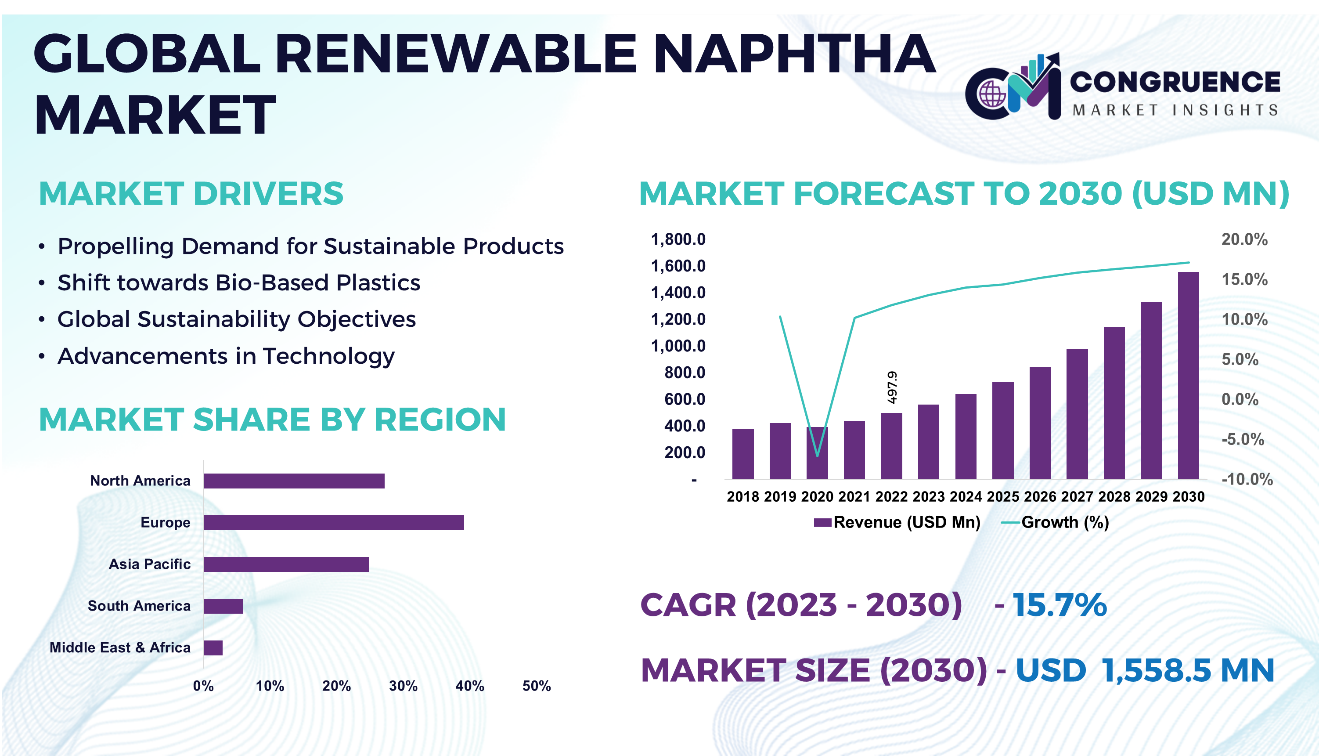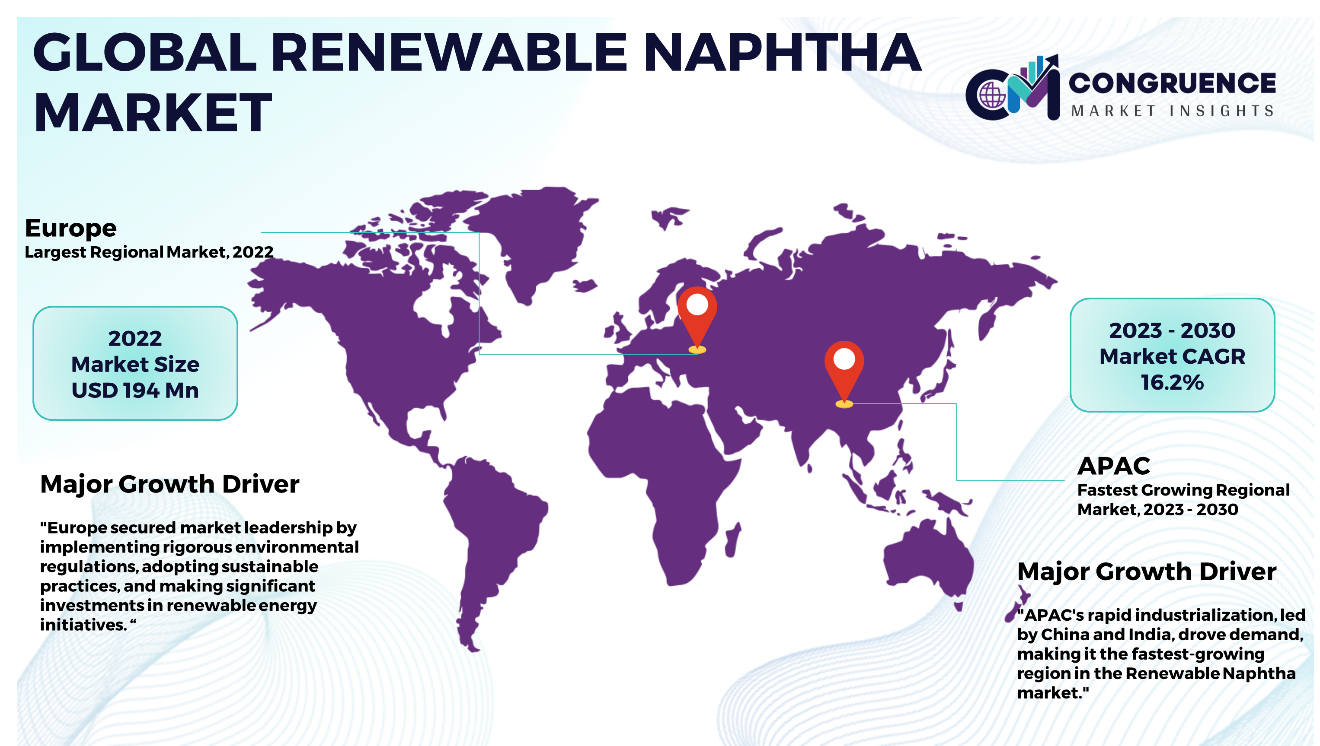Reports
The Global Renewable Naphtha Market was valued at USD 497.9 Million in 2022 and is anticipated to reach a value of USD 1,558.5 Million by 2030 expanding at a CAGR of 15.7% between 2023 and 2030.
The global market for renewable naphtha is currently undergoing robust growth, propelled by a heightened global commitment to sustainable business practices and the widespread transition to renewable resources. Renewable naphtha, derived from biomass, waste, and other sustainable feedstocks, assumes a pivotal role in the production of ecologically responsible transportation fuels, chemicals, and plastics. Market dynamics are being significantly influenced by escalated investments in research and development, fostering technological advancements, and fostering strategic collaborations within the industry. Notably, key sectors such as automotive, chemicals, and plastics are increasingly integrating renewable naphtha into their operations to align with stringent environmental regulations and diminish carbon footprints. The plastics and polymers industry, in particular, is undergoing a noteworthy shift towards the adoption of renewable naphtha as a primary feedstock, thereby contributing significantly to the broader objective of reducing reliance on conventional fossil fuels. While challenges such as cost competitiveness persist, the market exhibits a discernible trajectory towards heightened adoption, underscoring the global acknowledgment of renewable naphtha's pivotal role in propelling sustainability objectives forward.

Renewable Naphtha Market Major Driving Forces
Propelling Demand for Sustainable Products: Growing awareness and consumer demand for sustainable products are exerting pressure on industries to integrate renewable naphtha into their supply chains. Companies acknowledge the significance of offering eco-friendly alternatives to align with evolving consumer preferences.
Shift towards Bio-Based Plastics: The significant shift of the plastics and polymers industry toward bio-based materials is a key driver for the renewable naphtha market. As industries seek alternatives to traditional petrochemicals, renewable naphtha emerges as a critical feedstock in the creation of sustainable plastics.
Global Sustainability Objectives: The intensified focus on attaining worldwide sustainability objectives, which involve minimizing carbon emissions and reducing dependence on fossil fuels, stands as a primary catalyst for the renewable naphtha market. Industries actively pursue renewable alternatives to traditional naphtha to align with these overarching goals.
Advancements in Technology: Ongoing progress in technologies for renewable naphtha production is fostering enhanced efficiency and cost-effectiveness. Innovations in hydrotreatment, gasification, pyrolysis, and fermentation are broadening the viability of renewable naphtha as a pivotal component in the bio-based economy.
Renewable Naphtha Market Key Opportunities
Expansion of Bio-Based Plastics Manufacturing: Amid the global drive to diminish plastic waste and heightened awareness of environmental concerns, there is a surge in demand for bio-based plastics. Renewable naphtha, serving as a pivotal feedstock in the production of these environmentally friendly plastics, creates opportunities within the packaging and plastics sector.
Increasing Demand for Sustainable Aviation Fuels (SAF): The aviation sector's growing emphasis on minimizing its carbon footprint presents a significant growth prospect for renewable naphtha. As the aviation industry actively seeks sustainable alternatives, the utilization of renewable naphtha in the production of SAF emerges as a promising avenue for market expansion.
Advancements in Conversion Technologies: Continuous progress in technologies such as hydrotreatment, gasification, pyrolysis, and fermentation is unlocking new avenues for the efficient and cost-effective production of renewable naphtha. Opportunities abound in the ongoing enhancement and commercialization of these conversion technologies.
Renewable Naphtha Market Key Trends
· A prevailing trend shaping the renewable naphtha market is the escalating adoption of bio-based plastics.
· The renewable naphtha market is experiencing transformative trends propelled by continuous progress in conversion technologies. Innovations in hydrotreatment, gasification, pyrolysis, and fermentation are actively steering the market's evolution.
· Industries are exploring novel applications for renewable naphtha, including its utilization in lubricants, solvents, and specialty chemicals.
· Renewable naphtha is gaining substantial importance in the aviation sector, particularly as a key component in the production of Sustainable Aviation Fuels (SAF).
· A prevailing trend is the global emphasis on achieving carbon neutrality, driving industries to strategically incorporate renewable naphtha into their operations.
Region-wise Market Insights
Europe accounted for the largest market share at 39.09% in 2022 whereas, Asia Pacific is expected to register the fastest growth, expanding at a CAGR of 16.2% between 2023 and 2030.

The Renewable Naphtha Market undergoes diverse trends across various regions, delineated by influential factors including governmental policies, technological progress, and an overarching commitment to sustainability. In North America, the market has notably burgeoned, propelled by substantial investments in renewable energy initiatives and a steadfast commitment to curbing carbon emissions. The European region stands as a pioneer in the adoption of renewable naphtha, characterized by stringent environmental regulations and a proactive stance toward sustainable practices. Notably, Europe has become a focal point for advancements in the renewable energy landscape. Meanwhile, the Asia-Pacific region, spearheaded by economic powerhouses such as China and India, is witnessing a surge in demand propelled by rapid industrialization. This upswing is further fueled by an escalating awareness of the imperative for eco-friendly alternatives. It is crucial to emphasize that each region distinctly shapes the trajectory of the market, reflecting the nuanced regulatory frameworks and specific priorities inherent to local industries.
Segment-wise Market Analysis
· Biomass-Based Naphtha dominates the global renewable naphtha market's feedstock owing to its sustainable sourcing from organic materials, aligning with green energy initiatives. The process involves converting biomass into naphtha, offering an eco-friendly alternative. The dominance stems from its versatility, renewable nature, and the increasing emphasis on reducing dependence on conventional fossil fuels for a more sustainable energy landscape.
· Hydrotreatment holds dominance in Production Technology within the global renewable naphtha market due to its efficient conversion of feedstock into high-quality naphtha. Meanwhile, fermentation emerges as the fastest-growing technology type, driven by its eco-friendly process of converting organic materials into renewable naphtha, aligning with the increasing global focus on sustainable and bio-based solutions in the energy sector.
Market Competition Landscape
In this thriving sector, pivotal industry players actively vie for supremacy, engaging dynamically on the global stage. Firms strategically emphasize innovation, technological advancements, and the integration of sustainable practices to secure a competitive edge. These corporations consistently employ strategic tactics such as mergers, acquisitions, collaborations, and partnerships to fortify their market stance and extend their impact. The competitive dynamics are notably shaped by substantial investments in research and development, targeting continuous enhancement and a leading position in technological innovation. Initiatives for geographical expansion and an unwavering commitment to evolving environmental standards significantly contribute to the competitive standing of industry leaders. The heightened global demand for renewable and sustainable alternatives across diverse industries has intensified competition within the Renewable Naphtha Market. Companies find themselves compelled to distinguish their offerings by advancing efficient production processes and fostering a diversified portfolio of renewable naphtha products. This intricate and ever-evolving competitive landscape underscores the strategic imperative for industry players to consistently innovate and refine their strategies, ensuring a sustained and prominent market presence.
Key players in the global renewable naphtha market implement various organic and inorganic strategies to strengthen and improve their market positioning. Prominent players in the market include:
· Chevron Renewable Energy Group
· Topsoe A/S
· Montana Renewables, LLC (Calumet Specialty Products Partners, L.P.)
· UPM Biofuels
· Neste
· Marathon Petroleum Corporation
· Preem AB
· Phillips 66 Company
· TotalEnergies
· St1 Oy
· Borealis AG
· BASF SE
· Darling Ingredients
· Repsol
· XLS Biofuels
|
Report Attribute/Metric |
Details |
|
Market Revenue in 2022 |
USD 497.9 Million |
|
Market Revenue in 2030 |
USD 1,558.5 Million |
|
CAGR (2023 – 2030) |
15.7% |
|
Base Year |
2022 |
|
Forecast Period |
2023 – 2030 |
|
Historical Data |
2018 to 2022 |
|
Forecast Unit |
Value (US$ Mn) |
|
Key Report Deliverable |
Revenue Forecast, Growth Trends, Market Dynamics, Segmental Overview, Regional and Country-wise Analysis, Competition Landscape |
|
Segments Covered |
· By Feedstock Type (Biomass-Based Naphtha, Algae-Based Naphtha, Waste-Based Naphtha, and Others) · By Production Technology (Hydrotreatment, Gasification, Pyrolysis, Fermentation, and Others) · By Application (Transportation Fuels, Chemicals Production, Power Generation, Polymers and Plastic Manufacturing, and Others) · By End-Use Industry (Automotive, Energy and Utilities, Transportation, Plastic, Chemicals and Petrochemicals, and Others) |
|
Geographies Covered |
North America: U.S., Canada and Mexico Europe: Germany, France, U.K., Italy, Spain, and Rest of Europe Asia Pacific: China, India, Japan, South Korea, Southeast Asia, and Rest of Asia Pacific South America: Brazil, Argentina, and Rest of Latin America Middle East & Africa: GCC Countries, South Africa, and Rest of Middle East & Africa |
|
Key Players Analyzed |
Chevron Renewable Energy Group, Topsoe A/S, Montana Renewables, LLC (Calumet Specialty Products Partners, L.P.), UPM Biofuels, Neste, Marathon Petroleum Corporation, Preem AB, Phillips 66 Company, TotalEnergies, St1 Oy, Borealis AG, BASF SE, Darling Ingredients, Repsol, XLS Biofuels, and Others |
|
Customization & Pricing |
Available on Request (10% Customization is Free) |
